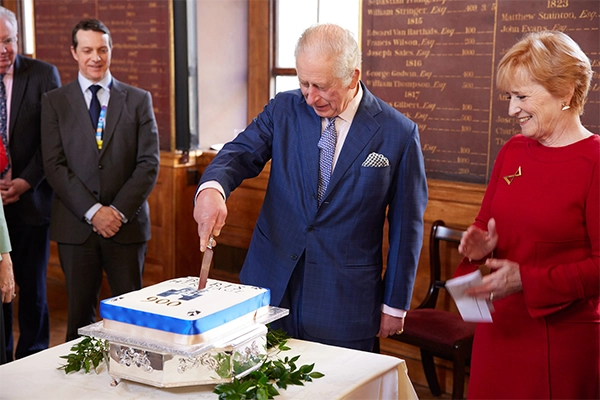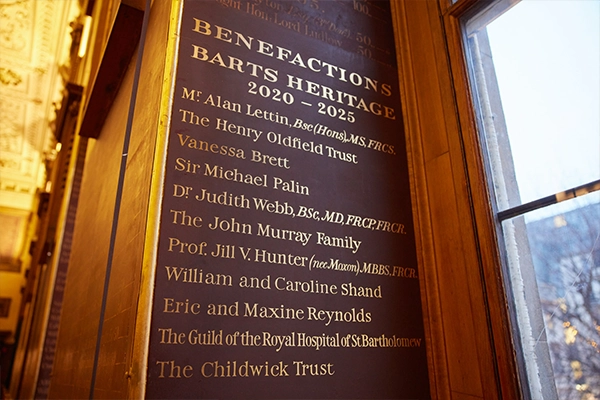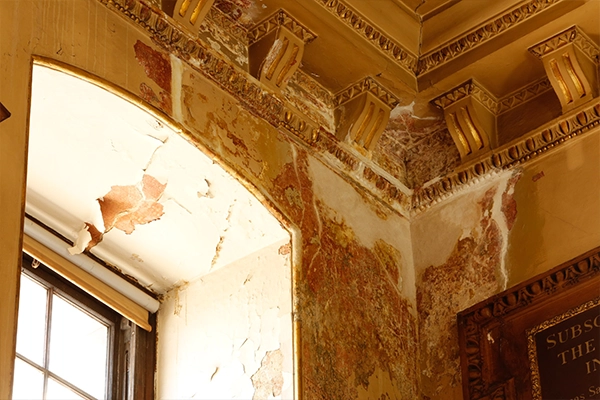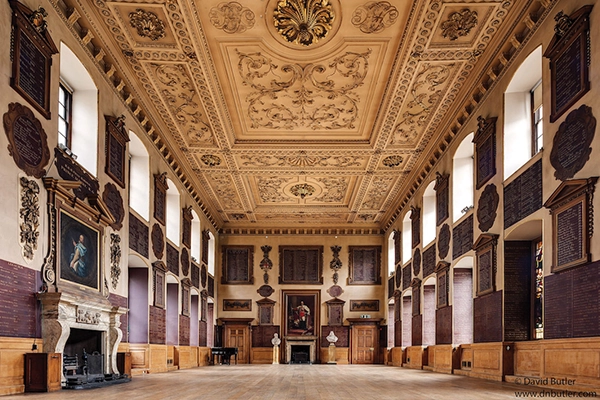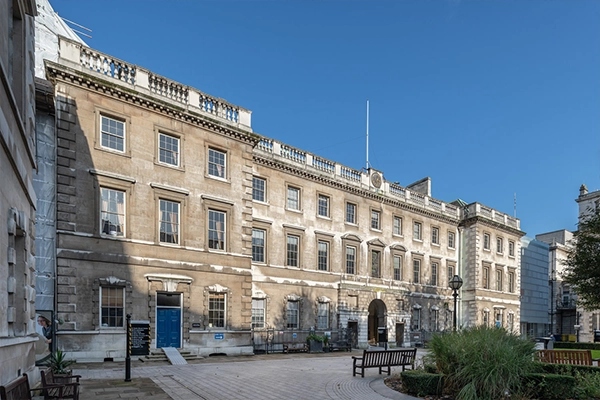19 July 2024
‘The King’s continuing Patronage is a huge boost’
8 minutes
His Majesty King Charles has reaffirmed his patronage of Barts Heritage just as the conservation charity’s work to oversee the restoration of the Grade I-listed North Wing at St Bartholomew’s Hospital gathers pace.
More than 900 years of philanthropy and care give St Bartholomew’s Hospital in the City of London a unique place in history and a major renovation project is under way to restore the Grade I-listed North Wing which includes two important interiors, the Great Hall and Hogarth Stair.
|
|
His Majesty King Charles has relinquished a huge number of patronages but as a strong supporter of the project he has reaffirmed that he will continue to be Patron of Barts Heritage, the charity led by chief executive Will Palin, which is working to preserve the heritage of St Bartholomew’s. Will said: “The King’s continuing Patronage of Barts Heritage – the role he took up in 2021 as The Prince of Wales – is a huge boost for our charity and to our ongoing restoration project. We hope very much that The King will return to see the completed work later in 2025.” The North Wing will open to visitors later in 2025 but from July this year until January 2025 the public can view conservation work on the ornate plaster ceiling and painted panels in the Great Hall, and to the William Hogarth canvasses, The Pool of Bethesda and The Good Samaritan. Will said: “We want people to be able to take part in behind-the-scenes tours, get up on the scaffolding, get up close to the work that the conservators and specialists are doing. (Image: HM King Charles, then the Prince of Wales cuts the 900th anniversary celebration cake in the great hall.) |
|
"Hogarth painted these remarkable canvasses in the mid-1730s, and they remain only a foray into large scale history painting. The works were intended to create a grand entrance to the Great Hall and impart the story of the Hospital and its charitable aims. In the spirit of philanthropy, Hogarth decorated the stairway free of charge.” Will says that although the paintings on the Hogarth Stair are almost 300 years old ‘they are in a stable condition’. He said: “They will require a surface clean and localised conservation work. More challenging will be dealing with the timber framework to which the canvases are attached to ensure that the surface is tight and secure. New lighting will transform the legibility of the paintings and, under the feet of visitors, the structure of the staircase will also be receiving attention. “The Pool of Bethseda is so large that Hogarth painted it off-site and brought it in to be installed. The Good Samaritan (painted in situ) represents modern medicine; this is man healing man, echoing St Bartholomew’s Hospital in action and the continuing work of doctors and physicians. “Many people who work at Barts, or who are cared for here, understand that these paintings are part of the rich and long history of this institution. For some, they provide comfort as reminders that the sick have been cared for on this site for many centuries. “There is of course a long tradition here of public philanthropy at Barts. For centuries, those who have given money were acknowledged in gold lettering on boards in the Great Hall.” (Image: Barts Heritage CEO Will Palin on the Hogarth Stair.) |
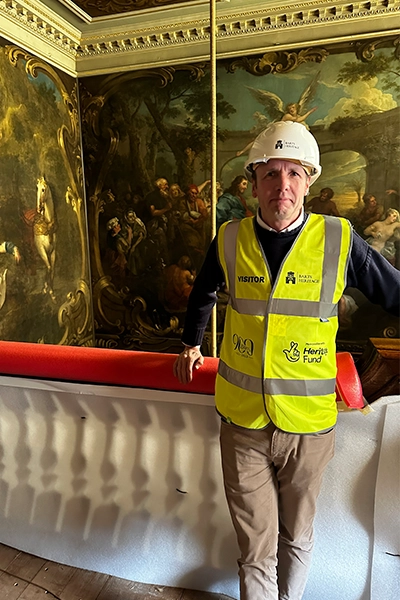 |
|
|
"There are 3,000 names on the walls of the Great Hall, benefactors motivated by a desire to do good things in this life and demonstrate, publicly, their support for this noble and ancient institution. “The fact there has been free healthcare on this site for 900 years is quite extraordinary and we’re delighted to be continuing this tradition as part of our project – although present day donors will need to give not £50 but £50,000 to earn a place on the walls.” So far, Barts Heritage has reached its fundraising target of £9.5 million for the first set of works. More than half has come from the National Lottery Heritage Fund and other grants from charitable trusts, city funders and generous gifts from individual donors, many of whom have close associations with the hospital. There is also a friends’ programme for people who want to keep up to speed with the conservation programme. “This precious building is in our care, and that is both a privilege and a huge responsibility,” said Will. “Funds are in place to complete the first phase of conservation work which began in January and on schedule to complete in autumn 2025 but there are financial challenges ahead. We are a start-up charity without significant reserves and reliant on grant funding. Managing cash flow is key ¬– and if even a single pledge is delayed you can find yourself in a difficult situation. (Image: A new Benefactor’ board contains names of generous supporters.) |
|
|
“The first phase will cover work by the envelope of the building – the roof, windows and exterior stonework, and the conservation and repair of the Great Hall and Hogarth Stair with the finest craftspeople employed to undertake this specialist work. “While all this is going on we need to keep the charity itself going and ensure once the building reopens that we can generate enough revenue to fund ourselves and the ongoing care and maintenance of this building – to which we have a 150-year lease. “There is a lot more we could do and there is a lot more we want to do. Addressing the archives and museum in the North Wing, and rejuvenating the Henry VIII Gatehouse, could easily form another £10-£20 million project. The key thing now is to build momentum and generate excitement and interest in the built heritage of the hospital. “The archive in the North Wing houses documents dating to the 12th and 13th century. Part of it is actually underneath my office. That is scary but obviously provides a wonderful and unique storytelling opportunity. “Current responsibility for the archive still sits with the hospital, but in the long term we would like to take more of an active role. (Image: Repairs to the Great Hall are now under way.) |
“This is the first time any historic building on the hospital site has been in the custodianship of a charity and we will have a role to play in supporting the archive and highlighting its importance and the need for more investment.
“There’s also a little museum here which needs updating so that will be part of the next phase.”
‘Beauty and tranquillity can help with recovery’
Will, who led the projects including the restoration of the Painted Hall at Greenwich, London, and Sheerness Dockyard Church, on the Isle of Sheppey, in Kent, says while every project has its special qualities Barts offers another dynamic, ‘the link between architecture and wellbeing’.
|
|
He said: “There is something about being close to beautiful buildings and historic sites that elevates the spirit and we are working with a range of partners, including Historic England on delivering a programme to link heritage and health for the benefit of patients, staff, visitors and the public.
“We are making that obvious point, just as churches have done for centuries, that a place of beauty and tranquillity can help with patient recovery and more generally with mental and physical health. Alongside the conservation work Barts Heritage is working to explore those ideas through our engagement programme funded by the National Lottery Heritage Fund. This programme will deliver a range of different activities for the benefit of staff, patients and the visiting public.
“A diverse workforce of 3,000 people come to the hospital each day, it’s a world-renowned centre for cancer treatment and one of the best (and busiest) cardiac centres in the world. When I first came here the only time the staff would come into the North Wing would be for hospital-run workshops or training sessions but when Covid arrived it became obvious they needed somewhere they could access that helped them get away from the stress of their work.
“We opened the Great Hall and some wellbeing spaces. This was well-received and with funding from the hospital’s own charity, these areas were refurbished giving staff rooms where they a take a little time out, have a cup of coffee and rest.
“We've learnt how important it is to provide spaces that are non-clinical in feel. The connection to culture, art and heritage allows people to reset.”
About St Bartholomew’s Hospital
St Bartholomew’s was founded together with the Priory of St Bartholomew in 1123 by Rahere, an Augustinian monk, to serve the sick and poor of London.
The priory was closed by Henry VIII but, following a petition from the City of London, the King handed the hospital to the City of London in 1546, and returned its confiscated property to provide an income.
A governing body was set up to administer the hospital, with paid officials, a matron, 12 sisters and three surgeons who could attend the poor daily.
|
The first physician was appointed in 1562 and the basic constitution of the hospital remained the same until the establishment of the National Health Service in 1948, although the medical and nursing staff had increased greatly during that time. Nurses were first mentioned in 1647 although a school of nursing was not founded at the hospital until 1877. All the medieval hospital buildings were demolished during the 18th century rebuilding programme, carried out to the designs of architect James Gibbs. Gibbs’ scheme created a new courtyard (The Square) framed by four new blocks, three of which survive, including the North Wing, which was the administrative centre. The Fountain in the Square was added in 1859. The hospital remained open throughout the World Wars although many services were evacuated to Hertfordshire and Middlesex in World War II. In 1954, the hospital became the first in the country to offer mega-voltage radiotherapy for cancer patients. Sir Bernard Tomlinson’s 1992 Report of the Inquiry into the London Health Service proposed the closure of the hospital, sparking an intense public debate and a campaign in which more than one million people signed a petition to save the hospital on its Smithfield site. The hospital remained open and in 1994 joined with The Royal London Hospital and London Chest Hospital. (Image: The Hogarth Stair courtesy of St Bartholomew’s Hospital Archives and Museums.) |
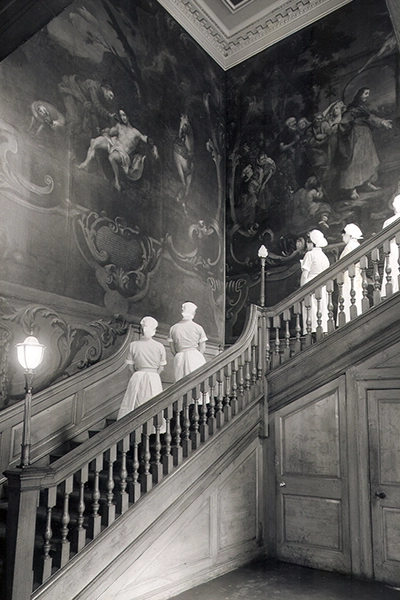 |
|
|
In 1995, the medical college merged with the London Hospital Medical College; as Barts and the London School of Medicine and Dentistry, it is now part of Queen Mary University of London. In 1999, the Royal Hospitals NHS Trust was renamed Barts and The London NHS Trust, and in 2012, when Whipps Cross and Newham University Hospitals joined the grouping, the new trust became known as Barts Health NHS Trust. Supported by general medicine and community services provided by its sister hospitals, St Bartholomew’s Hospital today is a specialist cardiac and cancer care centre. (Image: The North Wing south elevation. Credit Install Architects.) |
About Barts Heritage
Barts Heritage, was formed in 2017 to take on and repair the non-clinical historic buildings at St Bartholomew’s Hospital. In 2023 it took on a long lease for the North Wing and Henry VIII Gatehouse and embarked the Sharing Historic Barts project to repair, conserve and rejuvenate the North Wing. Visit bartsheritage.org.uk

